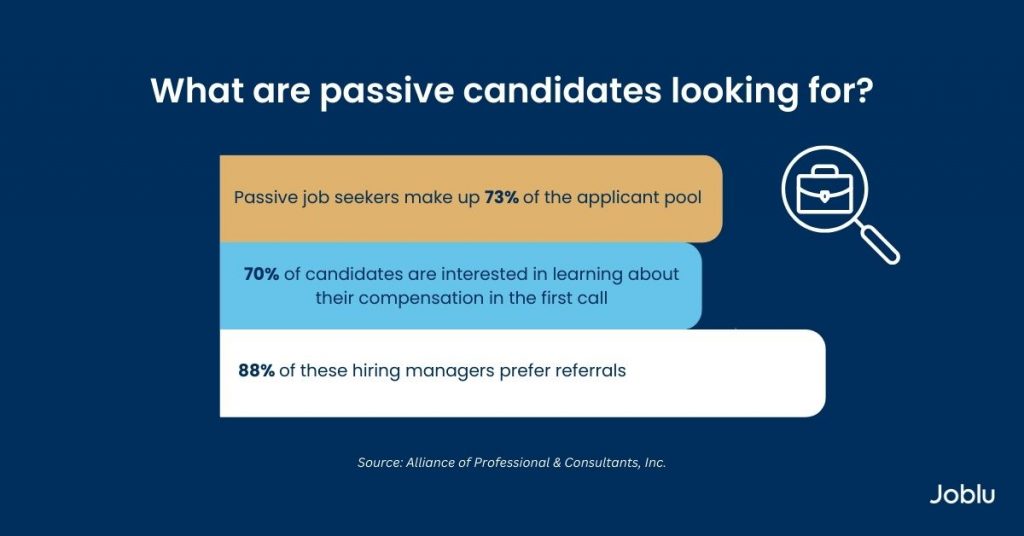Recruiting passive candidates has become a contentious issue in recent years with some hiring professionals being totally for and others completely against the practice.
The reality is that we need passive candidates if we’re going to make successful hires–and the idea of finding staff this way is as old as the concept of employment. Before broad-scale advertising opportunities were available, companies found employees by word of mouth or referrals as we call it now. Many referrals are not active job seekers and they wouldn’t have applied for the job had someone they trust not have told them about the opportunity.
Sourcing passive talent isn’t the solution to fill every vacancy, and hiring managers need to understand when to use this option and when not to. Many roles are quickly and successfully filled with active candidates. Specific industries require specialized skills that are often difficult to find. Sourcing passive experienced specialists can be the only option to get the skills you need on board.
Table of Contents
The Difference of Passive and Active Candidates
There’s a key difference between active and passive candidates, and it goes beyond just whether they are in the job market. Active candidates come to you and apply for jobs. They may read your job advertising and decide it’s something they want to pursue. If they are the right fit for your position, you have a better chance of hiring the candidate.
Recruiting active and passive candidates takes different strategies as well. When you’re looking for active job seekers, you spread your message far and wide. You’ll receive applications, and then it’s up to you to sift through the resumes to find the ones that fit your needs. With passive candidates, it’s the opposite. You define your needs and then go find matches.
Tried-and-true Methods for Sourcing Passive Candidates
With passive candidates, you have to polish your power of persuasion, as well as your sales skills, since they may not be very familiar with your company. Here are some tips to make the passive recruiting process as optimal as possible.
1. Look beyond job boards
Be creative! Consider where else you can find candidates outside of traditional online job boards. For instance, does it make sense to contact your state workforce, universities, etc…
You might also consider reaching out to recent hires for referrals. Now, some are even going as far as offering a referral program with bonuses or perks associated. Look to social media as well, but don’t think about just the traditional platforms. Branch out and join social media groups where the professionals you’re seeking naturally gather.
2. Give them what they’re not yet receiving
It’s human nature to aspire to what you can’t have. Sometimes the most effective way to win over passive candidates is to play off the weaknesses of their current employer. Study the company they’re working for, including the culture, work environment, benefits and growth opportunities. Find out where that company falls short. So when you talk to the candidate, you can emphasize how your company can fill in these gaps (without bashing their current employer).
3. Write emails that get to the point
It’s easy to fire off an email to potential candidates. The tough part is getting them to read it. When writing emails to candidates, a good rule of thumb is to keep your subject line to no more than 35 characters and the body of the email no longer than four to six sentences. It may take some time to fashion a strong and concise message. But when you find something that works, save it and reuse it when contacting other candidates.

What are Passive Candidates Looking for?
The key to recruiting passive candidates is to get their attention. Passive candidates are more satisfied with their current roles than active candidates–but that doesn’t mean that they aren’t open to better opportunities. So what would motivate them to make the switch?
For passive candidates, the number one motivation to change jobs is money, followed by work-life balance; active candidates are more interested in opportunities for advancement and more challenging work. Thus it is important to know what is considered a better opportunity by knowing the priorities of the type of candidate you are seeking.
Frequently Asked Questions about Passive Candidates
Q: How do you handle passive candidates?
A: To target passive candidates, employers should take the following steps:
- Look beyond job boards
- Give them what they’re not yet receiving
- Write emails that get to the point
Q: What is passive sourcing in recruitment?
A: Passive candidate sourcing refers to the process of reaching out to and engaging with candidates who are not actively looking for a job.
As a business owner or recruiter, you need every possible advantage to stay ahead of the competition. Today’s market calls for unconventional recruitment methods and passive recruitment checks all the boxes. Add to that, passive candidates offer a great way to widen your talent pool, rather than only considering candidates who are actively applying for jobs.
Ready to hire? Discover candidates at Joblu to grow your team now.